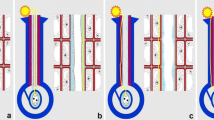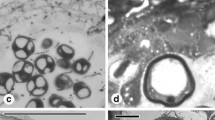Abstract
The ultrastructure of the style and pollen tube pathway before, during and after anthesis were studied in 13 species belonging to the tribes Pomaderreae, Paliureae, Colletieae and Gouanieae (Ziziphoid clade) and Rhamneae (Rhamnoid clade) using light microscopy and transmission electron microscopy. The aim of this study is to provide new morphological characters useful for phylogenetic analysis at suprageneric level in Rhamnaceae. The patterns of pollen tube growth and the ultrastructural changes undergone by cells of the style were also described. Species of Rhamneae (Scutia buxifolia and Condalia buxifolia) have a solid style, with the transmitting tissue forming three independent strands (S. buxifolia) or a central, single horseshoe-shaped strand as seen in transversal section (C. buxifolia) which could derive from the fusion of formerly independent strands. In contrast, Pomaderreae, Gouanieae and Paliureae showed semi-solid styles, while in Colletieae, as previously reported, the style is hollow with two or three stylar canals. The style anatomy and the ultrastructure of the pollen tube pathway show that there is a tendency towards a solid style with a single strand of transmitting tissue within the family. The three-canalled hollow style could be the plesiomorphic state of the character “type of style” in the family, the semi-solid style the synapomorphic state and the solid style with three strands of transmitting tissue the apomorphic state, with the solid style with a single strand of transmitting tissue as the most derived state. Therefore, Colletieae would be the most basal tribe of the Ziziphoid clade.












Similar content being viewed by others
References
Arora N (1953) The embryology of Ziziphus rotundifolia Lamk. Phytomorphology 3:88–98
Ciampolini F, Cresti M, Sarfatti G, Tiezzi A (1981) Ultrastructure of the stylar canal cells of Citrus limon (Rutaceae). Plant Syst Evol 138:263–274
Clarke AE, Considine JA, Ward R, Knox RB (1977) Mechanism of pollination in Gladiolus: roles of the stigma and pollen-tube guide. Ann Bot 41:15–20
Gasser CS, Robinson-Beers K (1993) Pistil development. Plant Cell 5:1231–1239
Gotelli MM, Galati BG, Medan D (2010) Structure of the stigma and style in sunflower (Helianthus annuus L.) Biocell 34(3)
Gotelli MM, Galati BG, Medan D (2012) Structure of the stigma and style in Colletia and Discaria (Rhamnaceae: Colletieae). Plant Syst Evol 298:1635–1641
Gotelli M, Galati B, Medan D (2016a) Ultrastructural studies of floral nectaries in Rhamnaceae. J Torrey Bot Soc 144:63–73
Gotelli M, Galati B, Zarlavsky G (2016b) Pollen development and anther morphology in 14 species of Rhamnaceae. Plant Syst Evol 302:1433–1444
Gunning BES, Pate JS (1969) Transfer cells: plant cells with wall ingrowths, specialized in relation to short distance transport of solutes—their occurrence, structure and development. Protoplasma 68:107–133
Hanackova Z, Piñeyro Lopez A (1999) The Karwinska parviflora flower. Biologia (Bratisl) 54:85–90
Hanf M (1935) Vergleichende und entwicklungsgeschichtliche Untersuchungen uber Morphologie und Anatomie der Griffel und Griffelaste. Beih Bot Zbl 54:99–141
Hauenschild F, Matuszak S, Muellner-Riehl AN, Favre A (2016) Phylogenetic relationships within the cosmopolitan buckthorn family (Rhamnaceae) support the resurrection of Sarcomphalus and the description of Pseudoziziphus gen. nov. Taxon 65:47–64
Herrero M, Dickinson HG (1979) Pollen–pistil incompatibility in Petunia hybrida—changes in the pistil following compatible and incompatible intraspecific crosses. J. Cell Sci 36:1–18
Hristova K, Lam M, Feild T, Sage TL (2005) Transmitting tissue ECM distribution and composition, and pollen germinability in Sarcandra glabra and Chloranthus japonicus (Chloranthaceae). Ann Bot 96:779–791
Johri BM (ed) (1984) Embryology of angiosperms. Berlin, Springer
Kajale LB (1944) A contribution to the life history of Zizyphus jujuba Lamk. Proc Nat Inst Sci India 10:387–391
Knox RB (1984) The pollen grain. In: Johri (ed) Embryology of angiosperms. Springer-Verlag, Heidelberg, pp 197–271
Laguna I, Cocucci AE (1971) El ovario, el óvulo y el megagametófito de Colletia spinosissima (Rhamnaceae). Kurtziana 6:53–62
Medan D (1985) Fruit morphology and seed dispersal in the Colletieae (Rhamnaceae).I The genus Discaria. Bot Jahrb Syst 105:205–262
Medan D, Schirarend C (2004) Rhamnaceae. In: Kubitzki (ed) The families and genera of vascular plants VI. Flowering plants—Dicotyledons: Celastrales, Oxalidales, Rosales, Cornales, Ericales. Springer Verlag, Heidelberg, pp 320–338
Pandey AK (1997) Introduction to the embryology of angiosperms. CBS Publishers and Distributors, Daryaganj
Pate JS, Gunning BES (1972) Transfer cells. Annu Rev Plant Biol 23:173–196
Prichard, EC (1955) Morphological studies in Rhamnaceae. J Elisha Mitchell Soc 71:82–106
Raghavan V (1997) Molecular embryology of flowering plants. Cambridge. University Press. 33-35
Reynolds ES (1963) The use of lead tissue citrate and high pH as an electron opaque stain in electron microscopy. J Cell Biol 17:208
Richardson JE, Fay MF, Cronk QCB, Chase MW (2000b) A revision of the tribal classification of Rhamnaceae. Kew Bull 55:311–340
Richardson JE, Fay MF, Cronk QCB, Bowman D, Chase MW (2000a) A phylogenetic analysis of Rhamnaceae using rbcL. and trnL-F plastid DNA sequences. Am J Bot 87:1309–1324
Rosenfeldt S, Galati BG (2000) Stigma and style morphology in Ceiba insignis (Bombacaceae). Phytomorphology 50:69–74
Rosenfeldt S, Galati BG (2009) The structure of the stigma and the style of Oxalis spp. (Oxalidaceae). J. Torrey Bot Soc 136:33–45
Suessenguth K (1953) Rhamnaceae, Vitaceae, Leeaceae. In: Engler, Prantl (eds) Die Naturlichen Pflanzenfamilien 2. Duncker and Humbolt, Berlin, pp 7–173
Talbot MJ, Wasteneys G, Mccurdy DW, Offler CE (2007) Deposition patterns of cellulose microfibrils in flange wall ingrowths of transfer cells indicate clear parallels with those of secondary wall thickenings. Funct Plant Biol 34:307–313
Tilton VR, Horner HT Jr (1980) Stigma, style, and obturator of Ornithogalum caudatum (Liliaceae) and their function in reproductive process. Am J Bot 67:1113–1131
Tortosa RD (1982) Organografía y vascularización de flores de Discaria, Colletia y Condalia (Rhamnaceae). Kurtziana 15:19–39
Perveen A, Qaiser M (2005) Pollen flora of Pakistan–XLIV. Rhamnaceae Pakistan J Bot 37(2):195–202
Prichard EC (1955) Morphological studies in Rhamnaceae. J Elisha Mitchell Sci Soc 71:82–106
Vasil IK (1974) The histology and physiology of pollen tube growth on the stigma and in the style. In: Linskens (ed) Fertilization in higher plants. North Holland Publ, Amsterdam, pp 105–118
Vasil IK, Johri MM (1964) The style, stigma and pollen tube. Phytomorphology 14:352–369
Vikhierva VV (1952) Morphologicoanatomical study of the fruits in the buckthorn family. Trudy Bot Inst Akad Nauk SSSR 7:241–292. [In Russian]
Watson ML (1958) Staining of tissue sections for electron microscopy with heavy metals. J Biophys Biochem Cytol 4:475–478
Weber M, Frosch A (1995) The development of the transmitting tract in the pistil of Hacquetia epipactis (Apiaceae). Int J Plant Sci 156:615–662
Wilms HJ (1980) Development and composition of the spinach ovule. Acta Botanica Neerlandica 29:243–260
Zarlavsky GE (2014) Histología Vegetal: Técnicas Simples y Complejas. Soc Argen Bot, Buenos Aires
Funding
This research was financially supported by a grant (UBACyT 2013–2016 GC 20020120100056BA) to B. Galati. M. Gotelli and D. Medan are affiliated with CONICET, Argentina.
Author information
Authors and Affiliations
Corresponding author
Ethics declarations
Conflict of interest
The authors declare that they have no conflicts of interest.
Additional information
Handling Editor: Benedikt Kost
Rights and permissions
About this article
Cite this article
Gotelli, M.M., Galati, B.G., Zarlavsky, G. et al. Structure of the style and pollen tube pathway in the Ziziphoid and Rhamnoid clades of Rhamnaceae. Protoplasma 255, 501–515 (2018). https://doi.org/10.1007/s00709-017-1167-z
Received:
Accepted:
Published:
Issue Date:
DOI: https://doi.org/10.1007/s00709-017-1167-z




